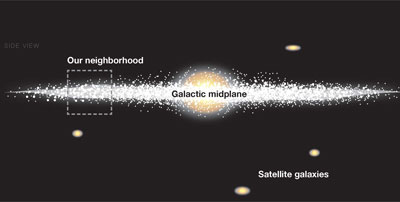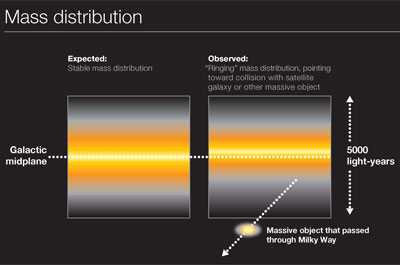
Milky Way rings like a bell after collision
BY AMANDA DOYLE
ASTRONOMY NOW
Posted: 2 July 2012


 A side view of our Galaxy, showing our position along with some satellite galaxies. Image: Fermilab
A side view of our Galaxy, showing our position along with some satellite galaxies. Image: Fermilab
An odd distribution of stars in the Milky Way has led astronomers to believe that our Galaxy is still shuddering after a recent collision.
The Milky Way has a fan club of more than twenty smaller satellite galaxies, and it has long been suspected that these galaxies will occasionally cross paths with our own. By following breadcrumbs in the form of 300,000 stars, scientists have found evidence that such an event happened only 100 million years ago. The perpetrator of the disturbance has yet to be identified, and could in fact be a massive lump of dark matter. There is much more dark matter in the Universe than visible matter, meaning there is a greater chance of an invisible dark matter satellite plunging through the Galaxy.
The scientists also considered other possibilities to explain the odd distribution of stars. For example, interstellar dust could cause the stars to appear redder, and thus dimmer, which can interfere with distance measurements. However, no alternate explanation withstood serious scrutiny, giving further strength to the collision theory.
The 300,000 stars were observed using the Sloan Digital Sky Survey, and the data revealed that they are not equally distributed north and south of the plane that divides the Galaxy. It is typical for a star's orbit around the centre of the Galaxy to allow it to dip in and out of the midplane, however the overall stellar positions should still result in equal numbers populating each side of the midplane. This asymmetry implies that the equilibrium of the Milky Way was shattered by a smaller body passing through the Galactic disc.
 A satellite galaxy passing through the Milky Way will cause an uneven distribution of stars around the midplane of the Galaxy. Image: Fermilab
A satellite galaxy passing through the Milky Way will cause an uneven distribution of stars around the midplane of the Galaxy. Image: Fermilab
"It's perhaps best to think of the stars in the disc of the Galaxy as a collective system of particles," explains Larry Widrow from Queen's University in Canada. "In fact, they behave almost like a fluid." The wavelike perturbation is similar to a rock being thrown into a pond. Our Galaxy is still showing evidence of these "ripples," but these will gradually die out and equilibrium will be restored.
"Eventually (we think perhaps over a few hundred million years) the perturbations will damp away and the system of stars will go back to an equilibrium distribution," says Widrow. However, for the Milky Way to stop ringing like a bell that has been struck, there have to be no further collisions, and that is not a guarantee. In fact it is possible the current "ringing" was caused by more than one collision.
ESA's Gaia spacecraft, due to launch in 2013, will chart around one billion stars in the Galaxy with exquisite precision, and this will provide further information on how exactly the stellar orbits have been perturbed by the intruder passing through the Milky Way.
|



